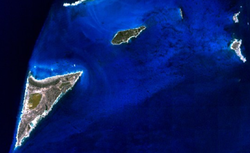Salt Cay
| Salt Cay | |
 Salt Cay from space | |
|---|---|
| Location | |
| Area: | 1,666 acres |
| Data | |
| Population: | 186 (2006 est.) |
Salt Cay is the second largest of the Turks Islands, one of the two island groups forming of the British overseas territory of the Turks and Caicos Islands.
Salt Cay is a tiny, flat, triangular island measuring about two miles on a side and given over mostly to salt pans. It was once home to several hundred people, all supported by the salt industry, though the population has shrunk to about 186 today.
The cay covers 1,666 acres, excluding dependents isles and islets such as Cotton Cay.
History
When the Spanish conquistador-explorer Juan Ponce de León came to the Islands in 1512, they were still inhabited by Arawak Indians who disappeared afterwards due to the diseases contracted from the Europeans and forced labour imposed by them.
Bermudians came to the islands in the 1673 century fleeing slavery and established what was to become the principal industry for the next 300 years - the production of salt from brine. The islands came under British colonial rule in 1766. It was Turks and Caicos salt that George Washington needed to preserve the food for his army during the American Revolutionary War and that the Canadian and American fishing fleets used to salt down their catches.
As late as the 1920s and 1930s, before a combination of competition, costs, mismanagement and the lack of a deepwater harbour brought the salt industry in the Turks and Caicos Islands to an end, as many as half a dozen sailing ships at a time would be anchored off Salt Cay awaiting cargo. The salt had to be ferried out to them over shallow water.
Ruins from the salt operations remain on Salt Cay. The island is now popular with tourists looking for uncrowded beaches and activities like whale-watching. Scuba diving and other water sports also attract visitors.
Humpback Whales of Salt Cay
The humpback whales of Salt Cay are North Atlantic Humpback Whales which migrate all the way along the North American coast up to the Gulf of Saint Lawrence and Greenland. Salt Cay is in the middle of the humpback whale’s annual migratory route to the Silver Banks, a humpback mating and nursery area, north of Hispaniola.
Silver Banks is a 75 square mile shallow coral reef area, an underwater plateau of limestone and it is believed that the whales choose this area for birthing and nursing because of the numerous coral heads which break the surface providing protection from ocean swells.
Great Sand Cay, about 9 miles south of Salt Cay, has been the “emergency room” to many expecting humpback whales through the years. Humpback whales born in the waters around Great Sand Cay and their mothers as well as other humpback whales are often spotted both by passengers on boats and from the shores of Salt Cay.